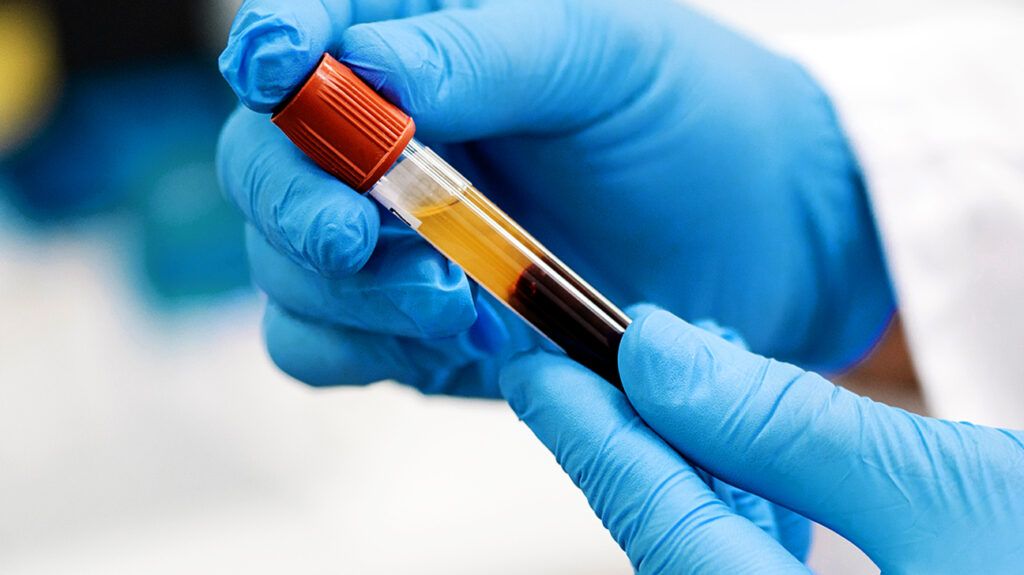The anion gap blood test measures the acid-base and electrolyte balance in the blood. Results can show whether there is an imbalance in a person’s pH levels, which may be making the blood too acidic or too alkaline.
A doctor may recommend this test if they suspect kidney problems or other metabolic disorders. A low anion gap is not usually a cause for concern but can be a sign of inflammation.
An anion gap is detectable in urine, plasma, or blood. This article focuses on the blood test, also known as the serum anion gap test. It investigates why doctors do the test, what to expect, and what it can show.

The anion gap blood test assesses the acid-base and electrolyte balance of the blood. It can help determine what may be causing disturbances in the blood’s pH.
Electrolytes are minerals in the body, such as sodium, potassium, chloride, and bicarbonate. These substances have an electrical charge, which can be positive or negative. For instance, sodium and potassium have a
The test uses results from an electrolyte panel to calculate a value. The anion gap value represents the difference between positively and negatively charged electrolytes in the blood, helping determine whether the blood is too acidic or too alkaline.
A high or low anion gap value can indicate various serious health issues, ranging from poisoning to kidney failure.
A doctor may recommend an anion gap blood test if they suspect:
- kidney disease
- diabetic ketoacidosis, when high levels of ketones build up in the blood
- dehydration
- poisoning with toxins
- medication overdose
Signs that a person may need an anion gap test include:
There is no need to prepare for an anion gap blood test.
At the test, a healthcare professional will:
- Wipe the injection site with a sterile solution.
- Insert a small needle, usually into the arm.
- Collect a blood sample in a test tube.
- Ensure there is no bleeding, and apply a dressing.
There are very minimal risks associated with an anion gap blood test.
A person may feel a sharp scratch as the needle enters the arm. Some people have a small amount of pain and bruising around the injection site for a while afterward.
An anion gap test will show whether a person has too much or too little acid in their blood.
Scientists use a complex calculation to assess the anion gap. For practical purposes, a result ranging from 4 to 12 millimoles per liter (mmol/L) suggests a healthy balance.
High levels
A
This can be a sign of:
- uremia, when waste collects in the blood due to kidney problems
- diabetic ketoacidosis
- high iron levels
- carbon monoxide or cyanide poisoning
- lactic acidosis, which can result from low oxygen levels due to heart failure and other conditions
- ethanol, methanol, or alcohol poisoning
- overuse of certain medications, including:
- prescription drugs, such as theophylline, an older bronchodilator
- some over-the-counter drugs, such as paracetamol, acetaminophen, or aspirin
Sodium, potassium, chloride, and bicarbonate are not the only substances that can affect pH. High or low levels of other electrolytes, such as magnesium, can affect the body’s pH level but may not appear in the panel.
Low levels
A low anion gap is rare but
- has low albumin levels, which can indicate inflammation
- is taking lithium to treat bipolar disorder
- has high levels of triglycerides, a type of fat, in their blood
A doctor will likely suggest repeating the test to check the results. If they need to know albumin levels, an albumin test is available.
A low anion result can also be skewed by
Here are some questions people often ask about the anion gap blood test.
What does the anion gap indicate?
An anion gap is a calculation based on the amount of electrolytes in the body.
It compares the levels of positively and negatively charged electrolytes — usually sodium, potassium, chloride, and bicarbonate — and assesses the body’s acid-base balance. High or low acid levels can indicate an underlying health problem.
Should I worry about a low anion gap?
A low anion gap is rare. It may indicate low albumin levels — a sign of inflammation — but doctors usually order a second test to check the result in case of error.
What cancers cause a low anion gap?
An
An anion gap serum test is a blood test that calculates the acid-base balance and electrolyte balance in the blood. A high anion gap suggests high acidity levels. This value can indicate kidney disease, diabetic ketoacidosis, and other health conditions, especially when paired with tests from other medical tests.
A low anion gap result is rare and does not necessarily indicate a health problem. However, it can occur if albumin levels are low, which can happen with inflammation.
